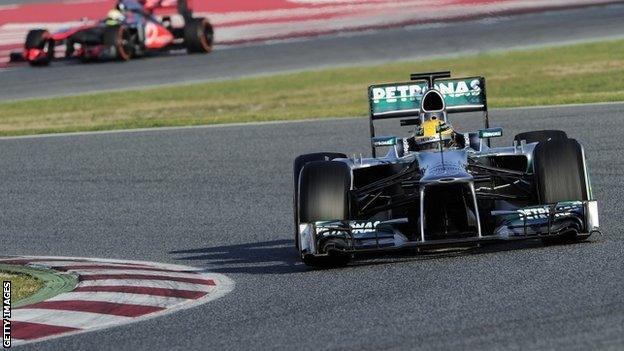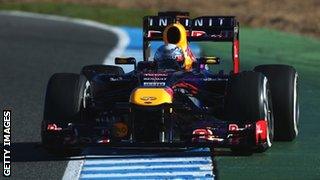Stage set for enticingly close Formula 1 season after final test
- Published
- comments

The eye-catching pace of Mercedes team-mates Lewis Hamilton and Nico Rosberg on the final two days of winter testing has added an extra degree of intrigue and excitement to a Formula 1 season that already promised a great deal.
On Saturday, Hamilton took the Mercedes around Barcelona's Circuit de Catalunya in one minute 20.558 seconds - three-quarters of a second faster than any other car managed on that day. Rosberg then lopped 0.428secs off Hamilton's time on Sunday.
The German was only 0.364secs quicker than Ferrari's Fernando Alonso - who also beat Hamilton's time - but Rosberg's pace underlined one aspect of pre-season testing that has become glaringly obvious the longer it has gone on. Mercedes have made startling progress from the end of last season, when they were struggling even to score points.
"You can clearly see Mercedes are fast," says McLaren sporting director Sam Michael. "They have been fast all the time."
Hamilton's time made such an impact that BBC F1 technical analyst Gary Anderson was moved to say he thought Hamilton and Mercedes could win the world championship this year.
For many, it was a bold claim. But what was particularly interesting was that Hamilton, who has spent all winter saying how the team's target was merely to get into the top 10 in the first qualifying session of the season on 16 March in Melbourne, did not completely rule it out.
"It's not 'no chance' and it's not definitely 'we will'," he said. "I think we definitely will be able to win a race at some point in the season. I hope we can at least. But when that will be, who knows?"
Hamilton's pace - and his 0.708secs margin over the rest of the field on the day - underlined the age-old problem with pre-season testing. Namely, what do the times mean?
After all, if you look down the list of fastest times from the two Barcelona tests in this feature, it clearly is not an accurate reflection of what the grid will be in Melbourne on the 16th.
Assuming normal, dry conditions and no unusual circumstances, it seems unlikely in the extreme that, for example, world champion Sebastian Vettel will be 12th in the Red Bull. Or that Force India's Adrian Sutil, back in F1 after a year away, is going to qualify seventh, ahead of a McLaren, both Lotuses and two Red Bulls.
So what is the true pace of all the cars in relation to each other?
It has been standard practice for years now for drivers and teams to say that winter testing is hard to read, and that they will not know for sure where they stand until qualifying in Australia.
In reality, though, usually they have a pretty good idea. But this year is different. Even senior team people seem genuinely unsure. The one thing that is clear, though, is that it is close at the front of the field - very close indeed.
How close? "There are nine teams within one second," says Michael, with the caveat that it is a "broad-brush estimation given the caveat of fuel loads, variability in track conditions and so on".
Another senior engineer said he found it impossible to split Mercedes, Lotus, Ferrari and Red Bull but that McLaren were a little way off in terms of ultimate speed and really not looking very good at all in terms of long-run pace.
Michael counters by admitting that McLaren's long runs have occasionally been slow, "but it depends which ones you look at; some are good and some aren't".
He adds: "We'll definitely be in the mix. In terms of confidence of whether we can be on the front row and win in Melbourne, I just don't know. I wouldn't say I was confident or unconfident. I'm neither way, just because I'm being honest. We just don't know."
The reason it's hard to split the teams is simple - the margins between the front-runners seem even tighter than last year, as most have predicted given only minor changes to the regulations.
The reason the list of fastest times does not bear a direct correlation with the competitive order is that teams set their fastest times on varying fuel loads - and when 10kg of fuel equates to 0.38 seconds in lap time, that makes a big difference.
The teams have a pretty good idea of the sorts of fuel loads their rivals run in testing, built up over years of experience, and they can use that to extrapolate ultimate pace, but only to a point - even where the teams are concerned, there is necessarily a bit of guesswork involved. They cannot be absolutely sure of the fuel load a driver is using at a given time, even if they have a good idea.
One engineer refers to this as "the 10kg noise" - in other words there is a 0.3-0.4secs margin of error in any of these predictions. That, in F1, is a lifetime.
And that is the problem with making any kind of prediction right now beyond the fact that it looks very tight at the front.
Let's take Red Bull as an example.
The car has rarely done outstanding lap times in testing and, from the numbers alone, there has been precious little evidence of it being a stand-out car.
But Red Bull are known to play their cards close to their chest in testing, careful never to reveal their true performance. Team boss Christian Horner calls this "concentrating on ourselves"; others call it "sandbagging" - deliberately disguising their true pace.
Vettel's fastest time this winter was a 1:22.194. But that was set at the second test, and tyre supplier Pirelli reckons the track was around 0.5secs a lap faster at the third.

Gary Anderson says the Red Bull looks like it has "more downforce than anything else"
Take off that 0.5secs and that gives Vettel a 1:21.694. Now assume he is running 60kg of fuel and that makes the Red Bull capable of a 19.414. But if he had 70kg, then it becomes a 19.034, which is that little bit faster than anyone else if you apply the same calculation based on the fuel loads the various teams are believed to run in testing.
Meanwhile, out on the track, the Red Bull, to use Gary Anderson's words, "looks totally planted, as if it just has more downforce than everything else". The McLaren, by contrast, has understeer. And the Ferrari lacks rear-end grip on corner exit.
And then there were Webber's late runs on Thursday. On a drying track, in tricky conditions in which downforce would be a huge help, Webber was repeatedly lapping at speeds way out of reach of anyone else.
He ended the day 1.655secs clear of the field - by far the biggest margin of any driver on any day during the winter.
Other teams warned not to read too much into Webber's times. He ran three sets of new tyres in a row, they said, and the track was in very poor condition having just dried out after a day of rain.
And of course, there are all the usual caveats - it's only testing, we don't know what fuel loads he was on, and, for his final lap time, he was on new 'soft' tyres and no-one else was.
But the caveats work the other way around, too. If we don't know what fuel the Red Bull was running when it was miles faster than anything else, it's also true that we don't know what fuel it was running when it looked ordinary.
So did Webber's pace in an apparently innocuous test session on Thursday inadvertently let the cat out of the (sand) bag, so to speak, revealing that Red Bull are sitting on a significant advantage?
I asked Webber that very question. "We'll find out on the 16th, buddy," he replied.
- Published3 March 2013
- Published2 March 2013
- Published2 March 2013
- Published1 March 2013